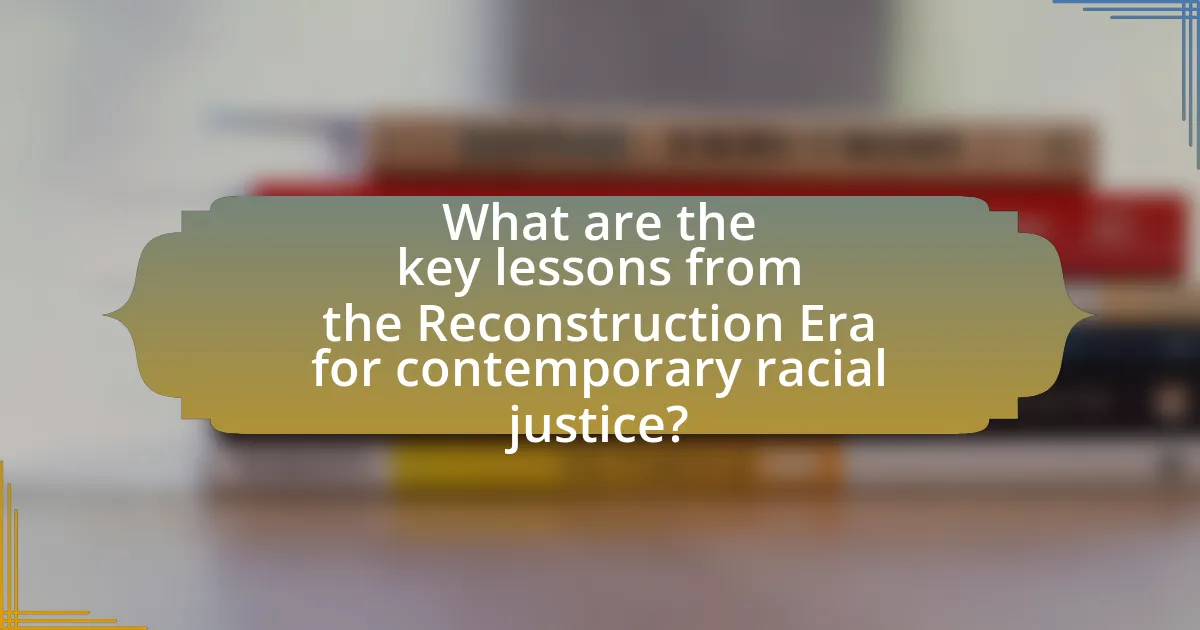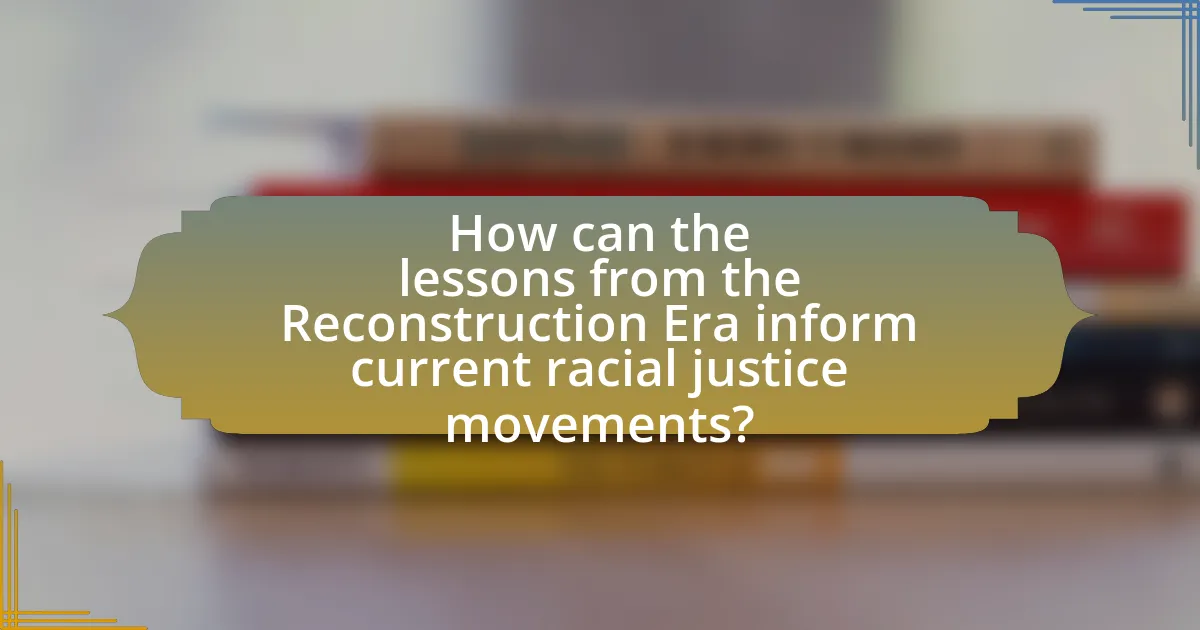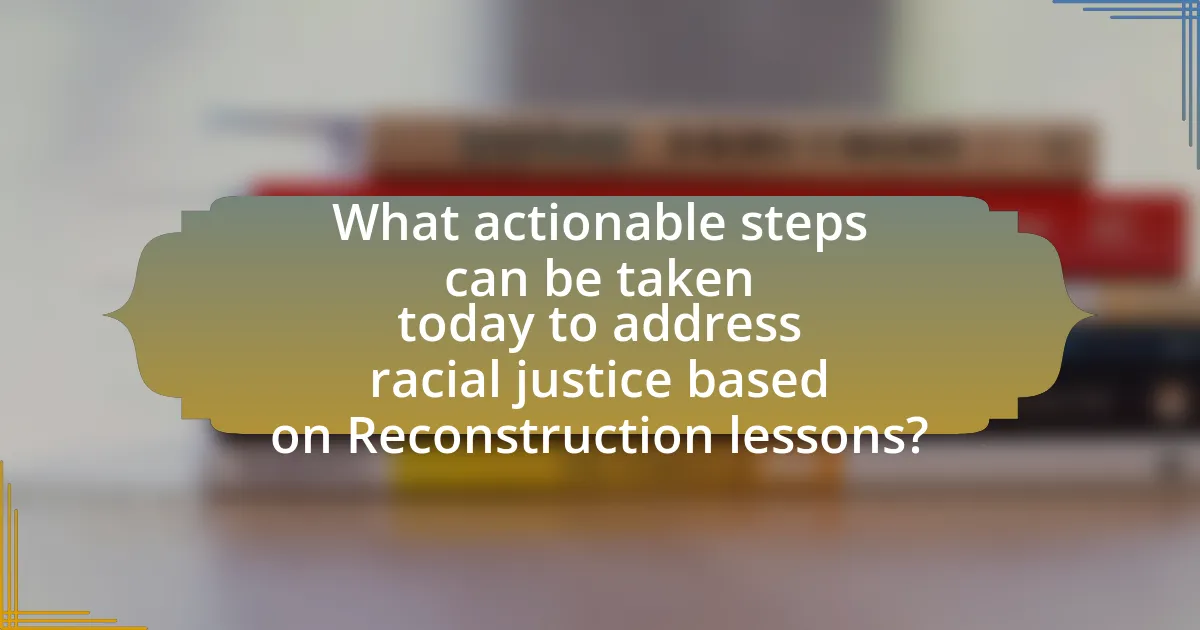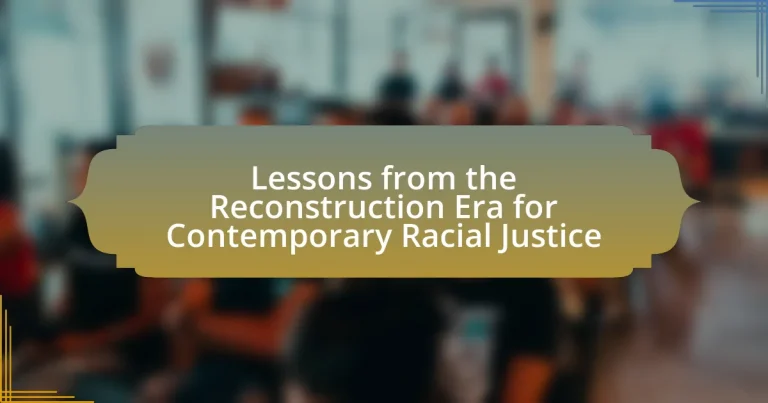The article examines the lessons from the Reconstruction Era that are relevant to contemporary racial justice movements. It highlights the significance of legal protections, political representation, and economic equity as foundational elements for achieving racial justice today. The discussion includes the impact of key policies such as the Civil Rights Act of 1866 and the 14th Amendment, the societal shifts in attitudes towards race, and the successes and failures of Reconstruction efforts. Additionally, it explores how historical injustices continue to influence current racial dynamics and offers actionable strategies for modern advocacy, emphasizing the importance of grassroots organizing and coalition-building in the fight for racial equity.

What are the key lessons from the Reconstruction Era for contemporary racial justice?
The key lessons from the Reconstruction Era for contemporary racial justice include the importance of legal protections, the necessity of political representation, and the need for economic equity. Legal protections, such as the Civil Rights Act of 1866 and the 14th Amendment, established foundational rights for formerly enslaved individuals, highlighting the ongoing need for robust legal frameworks to safeguard against discrimination today. Political representation was crucial during Reconstruction, as the election of Black officials demonstrated the significance of inclusive governance; this underscores the current necessity for diverse voices in political spaces to address systemic inequalities. Economic equity was also a focal point, as initiatives like the Freedmen’s Bureau aimed to provide resources and support for economic independence, emphasizing that contemporary racial justice efforts must include economic reforms to close wealth gaps and promote equal opportunities.
How did the Reconstruction Era shape racial dynamics in America?
The Reconstruction Era significantly shaped racial dynamics in America by establishing legal frameworks aimed at integrating formerly enslaved individuals into society as equal citizens. The passage of the 13th, 14th, and 15th Amendments abolished slavery, granted citizenship, and secured voting rights for African American men, respectively. These amendments marked a pivotal shift in racial relations, as they aimed to dismantle the institutionalized racism that had existed prior to the Civil War. However, the subsequent rise of Jim Crow laws and systemic racism in the late 19th century demonstrated the limitations of Reconstruction efforts, leading to a legacy of racial inequality that persisted for generations. This historical context illustrates the complexities of racial dynamics in America, highlighting both progress and setbacks in the pursuit of racial justice.
What policies were implemented during the Reconstruction Era to promote racial equality?
During the Reconstruction Era, several policies were implemented to promote racial equality, including the Civil Rights Act of 1866, the 14th Amendment, and the Freedmen’s Bureau. The Civil Rights Act of 1866 aimed to protect the rights of African Americans by granting them citizenship and equal protection under the law. The 14th Amendment, ratified in 1868, further solidified these rights by ensuring due process and equal protection for all citizens. Additionally, the Freedmen’s Bureau was established in 1865 to assist formerly enslaved individuals by providing education, healthcare, and employment opportunities, thereby facilitating their integration into society. These policies collectively aimed to dismantle the systemic inequalities faced by African Americans in the post-Civil War United States.
How did societal attitudes towards race change during this period?
During the Reconstruction Era, societal attitudes towards race shifted significantly, moving from a predominantly pro-slavery stance to a more inclusive perspective that recognized the rights of formerly enslaved individuals. This change was largely influenced by the passage of the 13th, 14th, and 15th Amendments, which abolished slavery, granted citizenship, and secured voting rights for African American men, respectively. The establishment of the Freedmen’s Bureau also played a crucial role in promoting education and economic opportunities for African Americans, further altering public perceptions. However, this progress faced backlash, leading to the rise of Jim Crow laws and systemic racism, indicating that while attitudes evolved towards greater acceptance, they were met with resistance that shaped future racial dynamics.
What were the successes and failures of the Reconstruction Era in achieving racial justice?
The Reconstruction Era had notable successes and failures in achieving racial justice. Successes included the establishment of the Freedmen’s Bureau in 1865, which provided assistance to formerly enslaved individuals, and the passage of the 14th and 15th Amendments, granting citizenship and voting rights to African Americans. These legislative measures aimed to integrate African Americans into society and protect their rights. However, failures were evident as well, including the rise of Jim Crow laws in the late 19th century, which enforced racial segregation and disenfranchised Black voters. Additionally, the Compromise of 1877 effectively ended Reconstruction, leading to the withdrawal of federal troops from the South and allowing white supremacist groups to regain control, undermining the progress made. Thus, while the Reconstruction Era initiated significant legal advancements for racial justice, systemic racism and political compromises ultimately hindered its long-term effectiveness.
What successes can be identified in the Reconstruction efforts?
The Reconstruction efforts achieved significant successes, particularly in the establishment of civil rights for formerly enslaved individuals. The passage of the 13th, 14th, and 15th Amendments to the U.S. Constitution abolished slavery, granted citizenship, and secured voting rights for African American men, respectively. These amendments laid the legal foundation for future civil rights advancements. Additionally, the establishment of the Freedmen’s Bureau provided essential services such as education, healthcare, and employment assistance to millions of freed slaves, facilitating their transition to freedom and contributing to the growth of African American communities.
What were the major obstacles that hindered progress during Reconstruction?
The major obstacles that hindered progress during Reconstruction included widespread racism, economic instability, and political opposition. Widespread racism manifested through the establishment of Black Codes, which restricted the rights of African Americans and aimed to maintain white supremacy. Economic instability was evident as the South struggled to rebuild its economy after the Civil War, leading to high unemployment and poverty rates among both Black and white populations. Political opposition arose from groups such as the Ku Klux Klan, which used violence and intimidation to undermine Reconstruction efforts and suppress Black political participation. These factors collectively stymied advancements in civil rights and social equality during this critical period in American history.

How can the lessons from the Reconstruction Era inform current racial justice movements?
The lessons from the Reconstruction Era can inform current racial justice movements by highlighting the importance of systemic change and the need for sustained advocacy. During Reconstruction, significant legal advancements, such as the 13th, 14th, and 15th Amendments, aimed to secure rights for formerly enslaved individuals, yet these gains were often undermined by systemic racism and violence, illustrating that legal reforms alone are insufficient without societal commitment to enforcement and equity. Historical evidence shows that the withdrawal of federal support and the rise of Jim Crow laws led to the erosion of these rights, emphasizing the necessity for ongoing vigilance and activism in contemporary movements to ensure that legal protections translate into real-world equity and justice.
What parallels can be drawn between the Reconstruction Era and today’s racial justice issues?
Parallels between the Reconstruction Era and today’s racial justice issues include systemic racism, the struggle for civil rights, and the impact of legislation on marginalized communities. During Reconstruction, the 13th, 14th, and 15th Amendments aimed to secure rights for formerly enslaved individuals, yet systemic barriers persisted, similar to contemporary challenges where laws intended to promote equality often face significant opposition and are undermined by discriminatory practices. For instance, voter suppression tactics today echo the Black Codes of the Reconstruction Era, which sought to limit the political power of African Americans. Additionally, both periods highlight the ongoing fight against social and economic inequalities, as evidenced by movements like Black Lives Matter, which seek to address issues rooted in historical injustices that continue to affect communities of color.
How do historical injustices continue to affect contemporary racial relations?
Historical injustices, such as slavery and segregation, continue to affect contemporary racial relations by perpetuating systemic inequalities and fostering mistrust among racial groups. For instance, the legacy of discriminatory policies, like redlining and voter suppression, has resulted in significant socioeconomic disparities that disadvantage communities of color today. According to a 2020 report by the Economic Policy Institute, Black workers earn 73% of what their white counterparts earn, highlighting the long-term economic impact of historical injustices. Additionally, the psychological effects of these injustices contribute to ongoing tensions, as communities grapple with the historical trauma associated with oppression. This context illustrates how the repercussions of past injustices shape current racial dynamics and hinder progress toward equity.
What strategies from the Reconstruction Era can be applied to modern movements?
Strategies from the Reconstruction Era that can be applied to modern movements include grassroots organizing, legal advocacy, and coalition-building. Grassroots organizing was pivotal during Reconstruction, as communities mobilized to advocate for civil rights and political representation, exemplified by the establishment of organizations like the Freedmen’s Bureau. Legal advocacy, demonstrated through landmark cases such as the Civil Rights Act of 1866, laid the groundwork for future legal battles for equality. Coalition-building among diverse groups, including African Americans, abolitionists, and labor unions, was essential for creating a unified front against systemic oppression. These strategies remain relevant today as modern movements seek to address racial injustice and promote equity.
What role does education play in understanding the Reconstruction Era’s impact on racial justice?
Education plays a crucial role in understanding the Reconstruction Era’s impact on racial justice by providing historical context and critical analysis of the policies and societal changes that occurred during that time. Through education, individuals learn about the establishment of the Freedmen’s Bureau, the passage of the 13th, 14th, and 15th Amendments, and the subsequent backlash that led to Jim Crow laws, which collectively shaped the trajectory of racial justice in America. Historical studies reveal that educational curricula that include these topics foster a deeper comprehension of systemic racism and its roots, enabling students to connect past injustices to contemporary issues. For instance, research by the Southern Poverty Law Center emphasizes that teaching about Reconstruction helps students recognize the ongoing effects of historical policies on current racial disparities.
How can educational initiatives promote awareness of Reconstruction’s lessons?
Educational initiatives can promote awareness of Reconstruction’s lessons by integrating comprehensive curricula that highlight the historical significance and outcomes of the Reconstruction Era. These curricula can include primary source documents, such as the 13th, 14th, and 15th Amendments, which illustrate the legal advancements made during this period, as well as the challenges faced in implementing these changes. Additionally, educational programs can facilitate discussions and workshops that connect historical events to contemporary issues of racial justice, thereby fostering critical thinking and engagement among students. Research indicates that when students learn about the complexities of Reconstruction, including the resistance to civil rights and the eventual rollback of gains, they are better equipped to understand and address ongoing racial inequalities today.
What resources are available for learning about the Reconstruction Era and its relevance today?
Comprehensive resources for learning about the Reconstruction Era and its relevance today include academic books, online courses, documentaries, and scholarly articles. Notable books such as “Reconstruction: America’s Unfinished Revolution, 1863-1877” by Eric Foner provide in-depth analysis and context. Online platforms like Coursera and edX offer courses on American history that cover the Reconstruction Era, often featuring lectures from university professors. Documentaries such as “Reconstruction: A History” present visual narratives that highlight key events and figures from the period. Scholarly articles in journals like the Journal of American History examine the implications of Reconstruction on contemporary racial justice issues, providing critical insights into its lasting impact. These resources collectively enhance understanding of the Reconstruction Era and its significance in today’s discussions on racial equity.

What actionable steps can be taken today to address racial justice based on Reconstruction lessons?
To address racial justice today based on lessons from Reconstruction, individuals and organizations can advocate for policies that promote equitable access to education, housing, and employment. Historical evidence shows that during Reconstruction, the establishment of schools for formerly enslaved people significantly improved literacy rates and economic opportunities, which are crucial for long-term racial equity. Additionally, supporting legislation that addresses systemic racism, such as the John Lewis Voting Rights Advancement Act, can help protect and expand voting rights, a key issue during the Reconstruction era when African Americans gained the right to vote. Engaging in community organizing and coalition-building can also amplify voices advocating for racial justice, reflecting the collective action seen during Reconstruction when African Americans and their allies fought for civil rights.
How can communities engage in discussions about racial justice informed by historical context?
Communities can engage in discussions about racial justice informed by historical context by organizing educational forums that highlight the Reconstruction Era’s impact on contemporary racial issues. These forums can include presentations from historians and activists who explain how policies and social dynamics from that period, such as the establishment of Black Codes and the subsequent civil rights movements, shape current racial disparities. For instance, the Reconstruction Era saw significant legislative changes, including the 13th, 14th, and 15th Amendments, which aimed to secure rights for formerly enslaved individuals but were met with systemic resistance, illustrating the ongoing struggle for racial equality. By examining these historical events, communities can foster a deeper understanding of the roots of racial injustice and encourage informed dialogue about current challenges and solutions.
What community programs can facilitate dialogue on racial issues?
Community programs that can facilitate dialogue on racial issues include facilitated discussion groups, community forums, and educational workshops. These programs create safe spaces for individuals to share experiences and perspectives, fostering understanding and empathy. For instance, the “Facing History and Ourselves” program provides resources for educators to engage students in discussions about race and identity, promoting critical thinking and reflection on historical injustices. Additionally, initiatives like “The People’s Institute for Survival and Beyond” focus on undoing racism through community training and organizing, which has been shown to enhance community cohesion and awareness. Such programs are essential for addressing racial issues and promoting social justice.
How can individuals contribute to racial justice efforts in their local areas?
Individuals can contribute to racial justice efforts in their local areas by actively participating in community organizations that focus on racial equity and justice. Engaging with local advocacy groups, such as the NAACP or local grassroots organizations, allows individuals to support initiatives that address systemic racism and promote equitable policies. Research indicates that community involvement can lead to significant changes; for example, a study by the Urban Institute found that grassroots movements effectively influence local policy changes related to racial justice. Additionally, individuals can educate themselves and others about racial issues, attend town hall meetings, and advocate for inclusive practices within local institutions, thereby fostering a more equitable community.
What best practices can be adopted from the Reconstruction Era for effective advocacy today?
Best practices from the Reconstruction Era that can be adopted for effective advocacy today include grassroots mobilization, coalition-building, and leveraging legal frameworks for civil rights. Grassroots mobilization was crucial during Reconstruction, as communities organized to demand rights and representation, exemplified by the formation of organizations like the Freedmen’s Bureau. Coalition-building among diverse groups, including African Americans, abolitionists, and labor unions, strengthened advocacy efforts, as seen in the push for the 14th and 15th Amendments. Additionally, utilizing legal frameworks, such as litigation to challenge discriminatory laws, was pivotal in advancing civil rights during this period, evidenced by landmark cases like Plessy v. Ferguson. These strategies remain relevant for contemporary racial justice advocacy, emphasizing the importance of community engagement, collaboration, and legal action.
What lessons can be learned from the advocacy strategies of the Reconstruction Era?
The advocacy strategies of the Reconstruction Era demonstrate the importance of coalition-building and grassroots mobilization in achieving social change. During this period, diverse groups, including formerly enslaved individuals, abolitionists, and Northern allies, united to push for civil rights and political representation, leading to significant legislative achievements such as the 14th and 15th Amendments. These strategies highlight that effective advocacy requires inclusive participation and the ability to leverage collective power to influence policy. The success of organizations like the Freedmen’s Bureau and the establishment of Black political leadership further illustrate that sustained advocacy efforts can lead to meaningful reforms, even in the face of systemic opposition.
How can these strategies be adapted to fit contemporary contexts?
Strategies from the Reconstruction Era can be adapted to contemporary contexts by emphasizing inclusive policy-making and community engagement. For instance, the establishment of equitable educational opportunities during Reconstruction can inform current efforts to address educational disparities through targeted funding and community-based programs. Historical evidence shows that the Freedmen’s Bureau successfully implemented educational initiatives that significantly increased literacy rates among formerly enslaved individuals. By applying similar frameworks today, policymakers can create programs that focus on marginalized communities, ensuring access to quality education and resources. Additionally, the use of grassroots organizing seen during Reconstruction can inspire modern movements for racial justice, fostering collaboration among diverse groups to advocate for systemic change.


